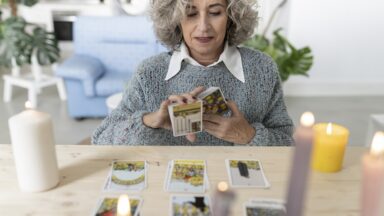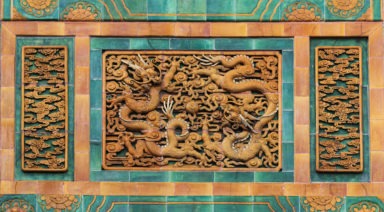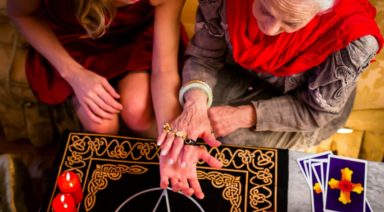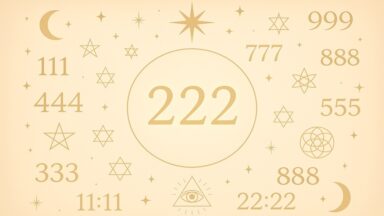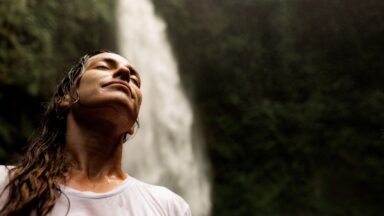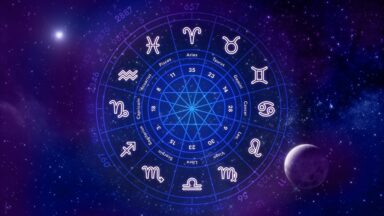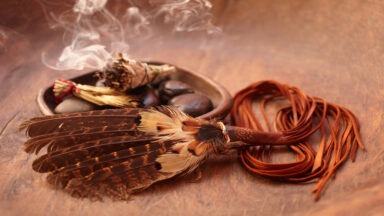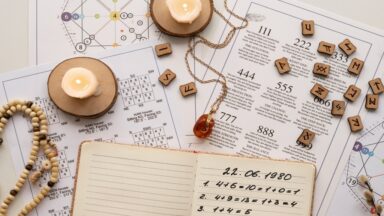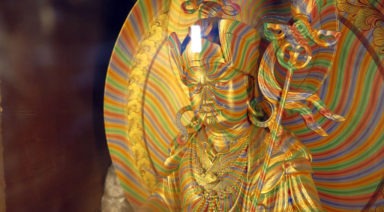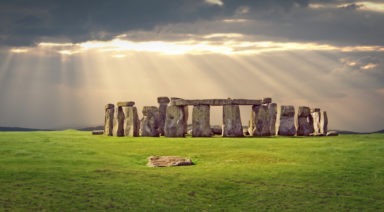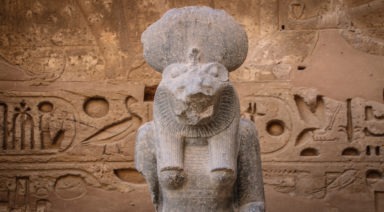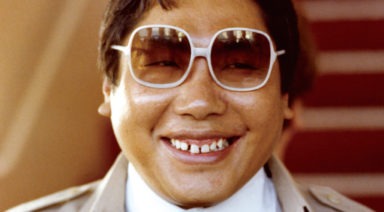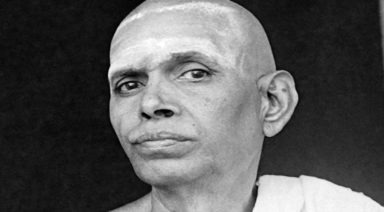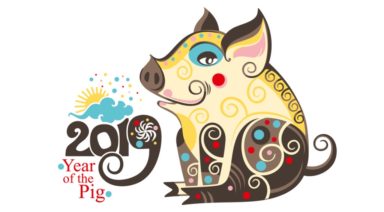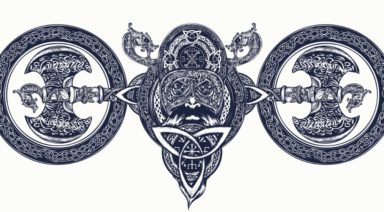Aleister Crowley’s Thoth Tarot: An Esoteric Primer
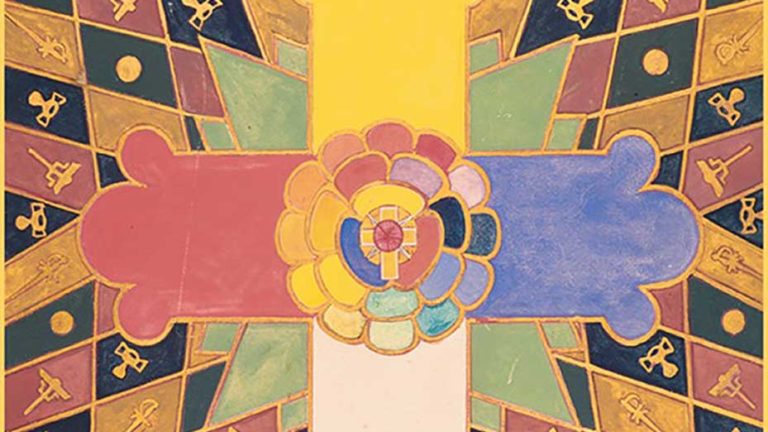
There may be more divination card decks on the market than kombucha flavors, and they just keep coming — animal, mineral, and vegetable (really) themes with everything in between — angels, a Spanish “Días de las Muertes” (Day of the Dead) deck, and a “Crystal Unicorn” tarot. There’s even a “Mystical Manga” deck. But all were preceded by 20th century occultist Aleister Crowley’s Thoth tarot, the product of 500 years of tarot history and Crowley’s vision.
Tarot History
The 14th century Italian aristocracy played a card game, “tarocchi,” using the oldest known cards, the Visconti-Sforza deck. Cards such as the fool, death, the sun, and justice, may have been derived from Venetian carnivale characters.
In 1789, a tarocchi-derived fortune-telling deck emerged, with 22 major and 56 minor arcana cards divided into coins, cups, swords, and wands suits representing the four elements — earth, water, fire, and air. Twenty-two trump cards correspond to the 22 paths on the kabbalistic tree of life. The oracle deck was linked to the Egyptian god Thoth, adding to the tarot’s air of mystery. The cards, their suits, and major arcana were also linked to gypsies, a disparaging name for the Romani people, who many believed were from Egypt (since disproven).
The Hermetic Order of the Golden Dawn
A fin de siècle fascination with occult subjects in literature and art grew throughout Europe into the early 20th century. Secret societies orders appeared, including The Hermetic Order of the Golden Dawn, an esoteric occult society. The Golden Dawn emerged in England and spread throughout Europe, with Crowley as a member of the London temple in 1898 — he fell out with the Golden Dawn in 1902, but was inspired to direct an esoteric order of his own.
“Crowley had been interested in Tarot since his involvement with the Hermetic Order of the Golden Dawn; indeed, one of the tasks of Golden Dawn membership was to create one’s own tarot deck based on traditional images and magical, qabalistic, and astrological information,” according to Lon Milo Duquette, author of the definitive Understanding Aleister Crowley’s Thoth Tarot.
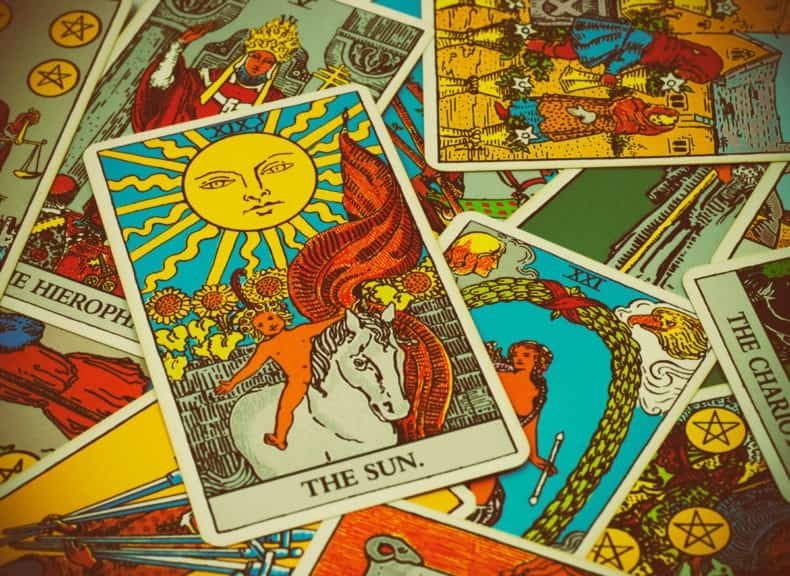
The Rider Waite Major Arcana Cards
Interest in the symbols with their layered meanings in the classic tarot was not exclusive to the Golden Dawn — the Waite-Smith deck, created by Golden Dawn member A.E. Waite, and illustrated by Pamela Colman “Pixie” Smith, was designed for commercial distribution.
“Waite and Pixie Smith were both Golden Dawn initiates, but Waite did not ask Smith to represent qabalistic and esoteric symbolism on the cards which were always intended to be marketed to the uninitiated. The images on Waite-Smith court cards and small cards were not qabalistically based at all, but drawn from visions Smith received while listening to readings from the Grail Romances,” said Duquette. The Waite-Smith deck evolved into the Rider Waite deck, now published by U.S. Games Systems. A version of the earlier Visconti-Sforza deck is also available.
Book of the Law and the Ordo Templis Orienti
In 1904, after leaving the Golden Dawn, Crowley travelled to Egypt. He reported that while there, he received a channeled text called “The Book of the Law.” At the heart of this text was the message, “Do what thou wilt shall be the whole of the law; love is the law, love under will.”
More visions came in 1909 during trips to Mexico and the Sahara Desert — Crowley used the experiences as inspiration for a series of initiations, similar to the Golden Dawn, but with an urgency based on Crowley’s belief that humanity was poised on the brink of profound evolutionary change.
In 1910, Crowley joined the Ordo Templi Orientis (OTO). Two years later he was the head of the OTO in Great Britain and Ireland. Eventually, as the “Outer Head of the Order” until his death in 1947, he integrated principles from his Book of the Law into ODO curriculums and raison d’etre.
Crowley’s Thoth Tarot
In roughly 1938, Crowley’s student, Lady Frieda Harris, suggested a re-imagined tarot based on the Book of the Law. She volunteered to produce all the art for the major and minor arcanas, saying she was directed to do so by her holy guardian angel. For the next several years, the two collaborated on the deck with Harris working tirelessly to translate Crowley’s vision to paint and canvas. According to Duquette, she had studied Rudolf Steiner’s concept of projective geometry with two of his students, and expressed those ideas in her compositions.
In his book on the Thoth tarot, Duquette writes, “When we ask what makes the Thoth Tarot unique, the first and most obvious answer is the artwork. However difficult it may be to grasp the mathematical subtleties of projective geometry, we see it thrillingly manifested in Harris’s use of lines, nets, arcs, swirls, twists and angles combined to visually redefine the fabric of space.”
The paintings, laden with symbols and references to kabbalah, astrology, alchemy, numerology, magickal correspondances, and The Book of the Law, were finished in 1943, and used to illustrate the first edition of Crowley’s “The Book of Thoth.” Crowley died in 1947, and Harris in 1952 — neither would see the paintings published as tarot cards. The Thoth Tarot deck would not be commercially published until 1969.
Duquette skillfully explores the similarities and differences between Crowley’s Thoth tarot and Golden Dawn tarot attributes. In his book he has published comparative charts illustrating complex relationships between the two systems, specifically those of the 22 trump cards, or major arcana.
The Fool
The rich symbolism in the Thoth deck, and comparisons of Crowley’s archetypes to their corresponding major arcana cards, has been accomplished in Duquette’s book. That said, a look at the fool card, the alpha and omega of any version of the major arcana, is an example of the contrast of traditional interpretation to Crowley’s vision.
The fool is one of the most complex symbols in Western esoterica, from mythology to standard playing cards, and Crowley held his own views on this symbol.

L. Rider Waite Tarot Fool R. Thoth Tarot Fool
The fool archetype can appear as the madman, the beggar, and the vagabond. He is usually in ragged clothing, often carries a staff, and is also portrayed with the classic jester’s hat with bells. He is first cousin to the archetypal Trickster — in fact, he often fills that role.
One source characterizes the fool as sacred, saying, “Holy fools subvert prevailing orthodoxy to point to the truth which lies beyond immediate conformity.” In other words, the fool points to the emperor’s new clothes as nakedness — he is the guileless child, and innocence is a prime characteristic of our fool. He disrupts anything safe or politically correct, exposing convention as hypocritical and counterfeit.
The fool is the clown and the court jester. In literature he appears as Shakespeare’s Puck in “A Midsummer’s Night Dream,” and in cinema, as Marx brother Harpo Marx, of whom Crowley was aware. Duquette writes, “Harpo was the archetypal fool — the girl-chasing clown who made fools of straightlaced, uptight characters — he did it without saying a word. Harpo was silent like the mythological characters from whom the fool is constructed; Harpocrates, the Greek god of innocence, and Dionysus, silent when asked by king Pentheus, “What is Truth?” Duquette notes finding images of Harpo Marx in Crowley’s own notes.
The Rider Waite fool is gazing into the sky above, about to step off a cliff — a little dog tries to warn him. The tarot fool is traditionally interpreted an indication of new beginnings, spontaneous action, leaps of faith, and innocence or naivete. When the card appears reversed, it indicates bad decisions or choices.
Crowley’s Thoth tarot Fool throws off simplistic meanings, presenting himself as a composite of several powerful symbols. Duquette writes, “He is the pagan Green Man of spring; Parsifal, the pure fool who wins the holy grail; Hoor-Pa-Kraat, the innocent Egyptian lord of silence treading on the back of the crocodile god Selbek, the Devourer.”
Duquette also notes that Harris’s portrayal is a “Cornucopia of sacred images, many of which reveal themselves only after long meditation (and the aid of a magnifying glass).” Harris’s fool is accompanied by a dove of innocence, or as Duquette suggests, the holy spirit. A butterfly references transformation. A vulture, shown in part above the butterfly, represents Maut, the Egyptian vulture goddess. Duquette interprets a winged globe as a symbol of Mercury, and quotes Crowley himself; “The whole picture is a glyph of the creative light.”
Every composition of the Thoth deck is multi-layered with meaning — some clear, others obscure or cryptic, based on Crowley’s interpretations. Every color, line, gesture, and object carries a symbolic message. As dive into Crowley’s Thoth deck is an immersive study of the occult, hermeticism, gematria, the Kabbalah’s tree of life, astrology, mythological gods and goddesses, and ritual magick.
100 Tarot Questions: What You Should and Shouldn’t Ask
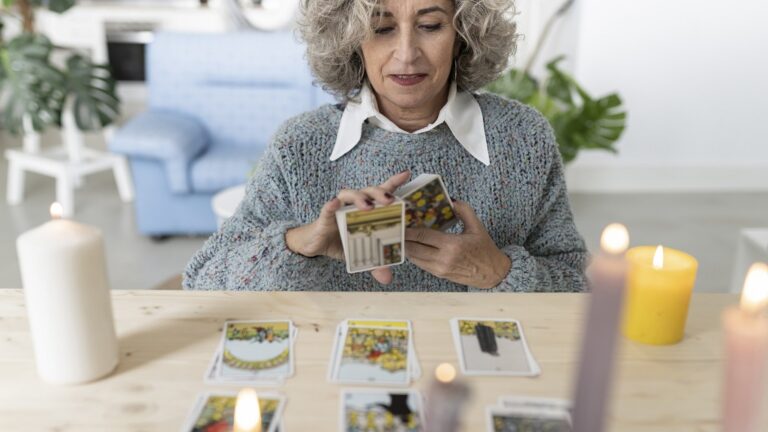
The Tarot offers a window into our inner world and a guide to facing challenges and making decisions. The key to getting useful answers lies in asking open and reflective questions. In this article, we explore the importance of questions, how to formulate them, how many to ask, and which ones to avoid in a Tarot reading.
Table of Contents
- The Importance of Questions in a Tarot Reading
- 100 Examples of Tarot Questions
- 10 General Questions
- 10 Questions About Love
- 10 Questions About Work
- 10 Questions About Finances, Business, and Money
- 10 Questions About Health and Well-being
- 10 Questions About Important Decisions
- 10 Questions About Family and Children
- 10 Questions About Spirituality
- 10 Questions About Past Lives
- 10 Questions About Life Purpose
- Do Tarot Cards Reveal the Future?
- What to Do with the Information from a Tarot Reading?
The Importance of Questions in a Tarot Reading
The questions we ask in a Tarot reading are crucial for the type of answers we receive. Well-formulated questions can provide clarity, direction, and understanding about various areas of our lives. On the other hand, vague or poorly phrased questions can result in confusing or unhelpful answers.
It’s essential to focus on questions that encourage reflection and self-awareness. Open-ended questions allow us to explore different aspects of a situation, offering a more complete and detailed perspective. This not only facilitates a better interpretation of the cards but also promotes a deeper and more meaningful internal dialogue, helping to uncover the true causes and possible solutions to the challenges we face.
In the series Mystery Teachings of the Tarot, available on Gaia, Dr. Theresa Bullard emphasizes the importance of asking questions that help us connect with our intuition and gain a clearer understanding of our circumstances. This series is an excellent guide for those who wish to deepen their Tarot readings and learn how to formulate effective questions to obtain useful and revealing answers.
How Many Questions Can I Ask?
There is no fixed number of questions to ask in a Tarot reading; it depends on individual needs and circumstances. A good number might be between three and five well-formulated questions, but this can vary depending on the depth of the answers you seek and the time available.
Limiting the number of questions helps avoid information overload. By focusing on a few questions, you can reflect properly on the answers received and apply the lessons learned to your daily life effectively. This allows you to explore each question in depth and maximize the value of the reading.
What Questions Should I Avoid in Tarot?
To get the best answers from the Tarot, it’s advisable to avoid questions that seek to predict specific events or depend on factors outside your control. Instead of asking, “When will I meet my soulmate?”, it’s more useful to ask, “What can I do to prepare my heart and life for a meaningful relationship?” This approach allows you to actively work on your personal development and be better prepared for future opportunities.
It’s also important to avoid questions that seek “yes” or “no” answers, as these don’t encourage deep dialogue or provide enough information for reflection. For example, instead of asking, “Should I change jobs?”, ask, “What should I consider when thinking about a career change?” This type of question opens the door to a more complete exploration of your options and circumstances, allowing for more detailed and enriching answers.
100 Examples of Tarot Questions
Below, we present 100 examples of questions in various areas of life that can help you make the most of your Tarot reading.
10 General Questions
- What is my life purpose at this moment?
- What do I need to know about my current situation?
- How can I overcome the obstacles I’m facing?
- What should I learn from my current challenges?
- How can I improve my overall well-being?
- What talents should I develop to achieve my goals?
- What is preventing me from moving forward in my life?
- How can I improve my personal relationships?
- What actions should I take to find inner peace?
- What should I know to make better decisions?
10 Questions About Love
- What can I do to attract a healthy romantic relationship?
- How can I improve my current relationship?
- What should I learn from my past romantic experiences?
- What qualities should I look for in a partner?
- How can I heal from a breakup?
- What is preventing me from finding true love?
- What do I need to know about my future love life?
- How can I communicate better with my partner?
- What aspects of my behavior are affecting my romantic relationships?
- How can I rekindle the passion in my relationship?
10 Questions About Work
- How can I advance in my professional career?
- What can I do to find a job I’m passionate about?
- What skills do I need to develop to succeed in my work?
- How can I improve my relationship with my coworkers?
- What should I consider when thinking about a career change?
- How can I better manage work-related stress?
- What is preventing me from achieving my professional goals?
- How can I find a better balance between my work and personal life?
- What opportunities for professional growth are available to me?
- What should I know about my current work environment?
10 Questions About Finances, Business, and Money
- How can I improve my financial situation?
- What should I know before making a major investment?
- What steps should I take to achieve financial stability?
- How can I better manage my personal finances?
- What should I consider when starting a business?
- How can I increase my income?
- What financial habits should I change?
- What financial opportunities are available to me?
- How can I free myself from debt?
- What is preventing me from achieving my financial goals?
10 Questions About Health and Well-being
- What can I do to improve my physical health?
- How can I better manage stress and anxiety?
- What habits should I adopt for a healthier life?
- How can I better balance my body and mind?
- What should I know about my emotional well-being?
- How can I strengthen my immune system?
- What is preventing me from achieving optimal well-being?
- How can I improve my mental health?
- What steps should I take to heal a specific ailment?
- What should I keep in mind to maintain a healthy lifestyle?
10 Questions About Important Decisions
- What should I consider when making this decision?
- What is the best path to follow in this situation?
- What consequences can I expect from this choice?
- How can I make a decision aligned with my values?
- What is preventing me from making a clear decision?
- What should I know before deciding?
- How can I find the courage to make this decision?
- What information am I missing to make this decision?
- How can I overcome the fear of making important decisions?
- What benefits will I gain from making this decision?
10 Questions About Family and Children
- How can I improve my relationship with my children?
- What should I know to better support my family?
- How can I foster a harmonious family environment?
- What family challenges do I need to address?
- How can I be a better parent?
- What can I do to improve communication in my family?
- What family patterns should I change?
- How can I better support my partner in parenting?
- What should I consider for my family’s emotional stability?
- How can I reconcile family differences?
10 Questions About Spirituality
- How can I deepen my spiritual practice?
- What should I know about my spiritual path?
- How can I better connect with my inner self?
- What spiritual lessons should I learn now?
- How can I balance my spiritual energy?
- What spiritual obstacles should I overcome?
- How can I find peace and spiritual balance?
- What spiritual practices should I incorporate into my life?
- How can I better align with my spiritual purpose?
- What should I know about my spiritual guides?
10 Questions About Past Lives
- What lessons from past lives are influencing my current life?
- How can I heal traumas from past lives?
- What should I know about my karmic connections?
- How have my past lives affected my current relationships?
- What talents from past lives can I use now?
- What repetitive patterns come from past lives?
- What vows or promises from past lives should I release?
- How can I better integrate the lessons from my past lives?
- What should I know about my experiences in other incarnations?
- How can I use the knowledge of my past lives for my personal growth?
10 Questions About Life Purpose
- What is my mission in this life?
- How can I discover my true purpose?
- What steps should I take to align with my life purpose?
- What is preventing me from fulfilling my purpose?
- How can I use my talents to fulfill my life mission?
- What should I learn to move forward on my life path?
- How can I better contribute to the well-being of others?
- What important lessons should I learn in this life?
- How can I live a more meaningful and fulfilling life?
- What should I know to fulfill my destiny?

Do Tarot Cards Reveal the Future?
The Tarot should not be seen as a tool that predicts the future in a fixed and immutable way. The cards reflect current energies and trends, suggesting possible paths and scenarios that could develop based on the querent’s decisions and actions. It’s essential to interpret Tarot answers with an open and contemplative mind, understanding that they offer guidance based on the present, not an absolute prediction of the future.
Rather than fixing destiny, the Tarot provides insight into the influences and opportunities present in the querent’s life. The cards can reveal behavioral patterns, blockages, and potentials that help in making informed decisions. The purpose of the Tarot is to empower the querent, providing the tools needed to navigate their circumstances with greater clarity and wisdom.
Querents should use the information obtained from the Tarot as a guide to reflect and make decisions based on their own judgment and inner wisdom. By doing so, they can make the most of the lessons and advice the cards offer, adapting their actions to better align with their personal goals and values. When used consciously, the Tarot becomes a powerful ally for self-awareness and personal growth.
What to Do with the Information from a Tarot Reading?
Once you’ve obtained the information from a Tarot reading, it’s important to take the time to reflect and process the answers. It’s recommended to jot down the ideas and feelings that arose during the reading to review them later. This practice not only helps you remember important details but also allows for continuous reflection on how to apply the advice received in daily life.
Applying the information obtained is the next important step. This involves taking concrete actions based on the Tarot’s suggestions, whether by adjusting behaviors, exploring new opportunities, or facing challenges in a different way. Integrating these changes into your daily routine can lead to significant growth and transformation, better aligning your actions with your personal goals and values.
Finally, it’s helpful to regularly review past readings to see the progress and changes that have been made. This not only reinforces the understanding of the Tarot’s messages but also allows you to adjust your course of action as needed. The process of continuous review and adjustment is key to maintaining an effective connection with the guidance provided by the Tarot, ensuring it remains relevant and useful over time.


